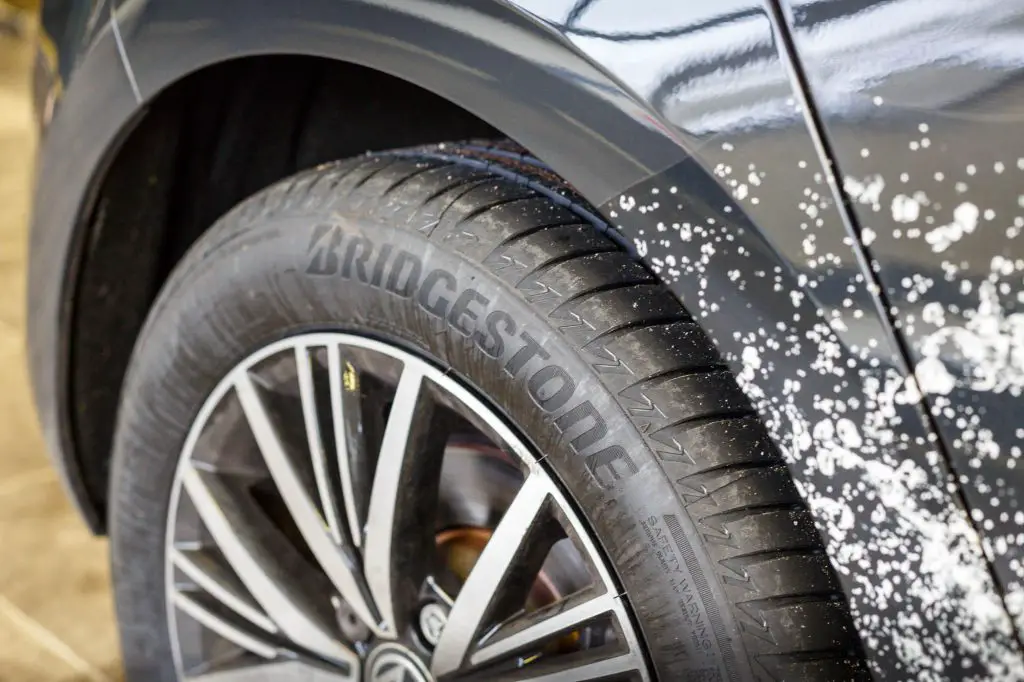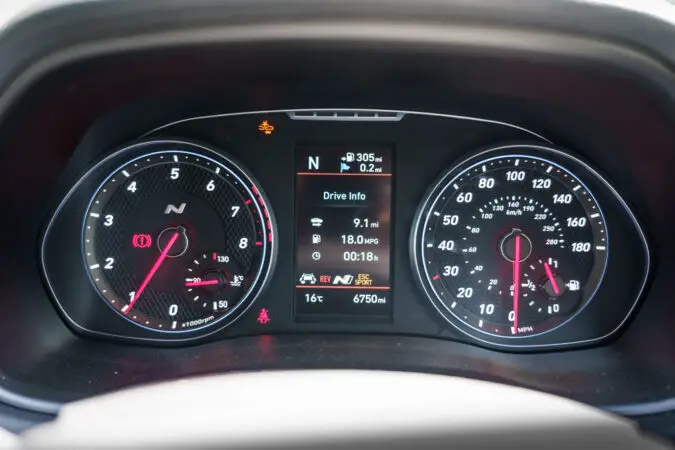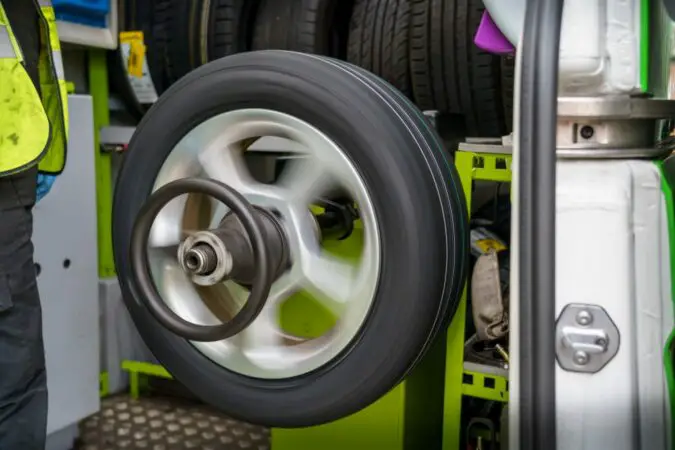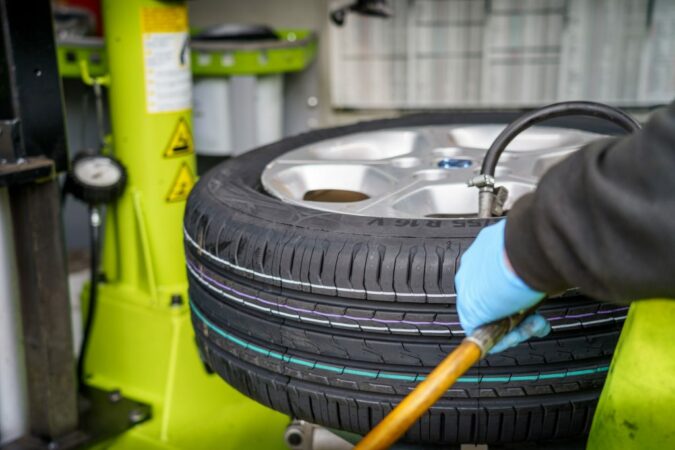Unbalanced tires are when the distribution of mass within your tires is uneven. This will happen over time, and when you have unbalanced tires, you’re going to have to perform a tire balancing.
This article will discuss everything about tire balancing and how to maintain your tires in general. If you think you have unbalanced tires, you’re going to want to read on:
Why Do Tires Become Unbalanced?
So, your first question is probably why do tires become unbalanced? Your tires become unbalanced either because of uneven tire wear or when one of the wheel weights shifts or even goes missing. Or in some cases, it may be both.
You might not know this, but your wheels have weights on the side of the rim. These weights are installed in a precise location that acts as a counterbalance. This ensures that the wheel’s mass is distributed evenly around the axis of rotation.
Over time, these weights may shift or even fall off from the wheel. This usually happens when your wheel hits a curb or a pothole. The vibration of it causes the wheel weight to shift. As a result, the weight is no longer where it’s supposed to be and throws off the tire’s mass distribution balance.
Uneven tire wear can also affect the tire’s balance. As the tires wear down, the balance and mass distribution of the tires will change. This means the original weight positioning is no longer appropriate and they have to be moved.
Note that uneven tire wear – especially between tires on the same axle – is usually a sign of suspension problems. This means not only do you have to do a tire balancing, but you’ll also need to inspect your car’s suspension to find out why your tires were uneven in the first place.
Anyway, tire balancing fixes unbalanced tires by moving the weights to the appropriate location. The location will differ depending on the wheel and tire dimensions, as well as the condition of the tires.
Signs You Have Unbalanced Tires
So, that’s how tires become unbalanced over time and why you need to do tire balancing every once in a while. Now, let’s take a look at the signs of unbalanced tires:
1. Steering Wheel Vibration
The most common sign of unbalanced tires is steering wheel vibrations. Since the wheel’s mass isn’t distributed properly, this causes the wheel to vibrate and wobble as you drive along. This vibration is then transferred to the steering wheel since it directly connects to the wheels.
In most cases, the vibration will appear only at high speeds. Usually when your car goes over 50 mph, or sometimes it won’t appear up until 60mph. However, the vibrations may appear as early as 30mph in severe cases.
Note that if your vibration happens only during braking, then this is not a tire balance problem. Instead, the problem lies with your braking system. This usually means you have worn brake pads, although it may also be a brake rotor/disc problem.
Steering wheel vibration is usually a sure sign that you have a tire balance problem. If you’re experiencing this, it’s time to do a tire balancing. If that doesn’t fix your problem, then you might have a problem with one of your suspension components.
2. Other Steering Problems
Other steering problems may occur if you have unbalanced tires. This includes a sluggish steering feel and changes in the car’s handling. Often they’re quite hard to notice, but if you do, it’s worth getting a tire balancing job to see if it fixes the problem.
It can be hard to distinguish a steering problem that’s caused by unbalanced tires or by worn steering components. If the change in steering feel and handling is minor, then it’s likely to be a tire problem.
But if you’re experiencing major issues with the steering, such as loose-feeling or playing in the steering wheel, this is more likely a problem with the steering system. A very heavy steering wheel is also unlikely to be a tire balance issue, but more likely a problem with the power steering system.
We wrote a comprehensive guide about the steering system. We recommend reading it if you think you may have an issue with your steering system rather than with your tires.
3. Uneven Tire Wear
If you have uneven wear between the front and rear tires, this is usually because you haven’t done a tire rotation. The front tires tend to wear faster because they have to steer the car, even more so in front-wheel-drive cars.
You need to perform a tire rotation (swapping the front and rear tires) between 6,000 – 8,000 miles to ensure even wear between them. However, if uneven tire wear happens between the front left and right tires, this could be a sign of unbalanced tires.
When the tires are out of balance, one tire is likely to be handling more mass than the other. As a result, that tire will undergo more stress and wear out quicker than the other.
As mentioned, uneven tire wear can also happen when you have a suspension problem. If a suspension component on one side has worn out, it may put excess stress on one tire resulting in uneven tire wear.
The video above is a helpful guide on how to identify what caused the uneven tire wear. Depending on how the tires wear, it may be something simple like an over or underinflated tire. Or it can also be a more serious problem such as bad suspension components.
If it happens to be the latter, you’ll want to address the problem immediately. Ignoring it will continue your uneven tire wear problem, which can shorten the lifespan of your tires.
4. Worse Fuel Consumption
Unbalanced tires can affect your fuel consumption, albeit slightly. Some suggest that proper tire balancing on all four tires will improve fuel consumption by about 2.2%. So, you might lose around that much as well if you have unbalanced tires.
This is because unbalanced tires can increase the rolling resistance on your tires. This means your car will need more power to overcome the resistance, resulting in worse fuel consumption.
If your car doesn’t have an on-board fuel consumption monitoring system, you probably won’t notice this. And if you have significantly worse fuel consumption, there’s probably a different issue with your car.
Improper tire inflation can also affect fuel consumption. Check and inflate your tires to the manufacturer’s specifications. You can find this on a sticker on the driver’s side door. In most cases, it’s usually around 32 – 36 PSI, unless you’re carrying heavy loads in the car.
If the problem persists after doing a tire balancing and inflating the tires to the correct pressure, you probably have a problem with the engine. This is usually either an air intake or fuel system problem.
5. Worn Shock Absorbers Or Bearings
The shock absorber is a hydraulic device with springs around it that absorbs bumps as you drive along. This is the component many people often refer to when they say suspension. Meanwhile, the wheel bearing is the component that connects the wheel to the axle and allows it to rotate with minimal friction.
Unbalanced tires can eventually wear out the shocks and/or bearings since it forces these parts to work harder. But bad shocks and bearings can also cause the tires to become unbalanced, so it goes both ways. Therefore, be wary of the symptoms of bad shocks.
Shock absorbers usually last for about 5 years or 50,000 miles. Although in some cars, especially in trucks and body-on-frame SUVs, they can last for up to 10 years or 100,000 miles. Meanwhile, wheel bearings usually last about 85,000 – 100,000 miles.
If these components wear out quicker than they should, then unbalanced tires may be the cause. In any case, you’ll need to address this problem since worn suspension components can compromise your safety.
Signs of worn shocks include knocking noises, excessive body roll and/or bouncing, and excess tire wear amongst others. Meanwhile, worn wheel bearings (it might be time to find wheel bearing repair shops near me) usually cause a humming or growling noise when you drive, as well as wheel wobble that can cause the steering wheel to vibrate. If your steering wheel vibration persists after a tire balancing, it’s a good idea to check the wheel bearings.
Unbalanced Tires: Tire Balancing Cost
So, now that you’ve verified that you have unbalanced tires, how much will it set you back to perform a tire balancing? Thankfully, not a lot. In most cases, tire balancing costs about $10 per tire. You can do only the front or rear tires if you like. But ideally, you should do all four at once, so that brings the cost to $40 in total.
Keep in mind that certain wheel and tire sizes may cost more. You can expect a tire balancing to cost up to $80 for some cars. But regardless of your tire and wheel size, the labor cost is already built-in to this price.
The process entails taking off the wheels from your car. Afterward, the technician will put the tires into the balancing machine to check the rotation. They’ll install, move, or remove the wheel weights appropriately until the machine says the tire’s rotation is balanced.
Our tip is to ensure that there are no hidden costs to the job. Some tire shops may do a suspension and wheel checkup without telling you and then charging you for the job.
If you don’t want to pay any more than you have to, ensure that they won’t do this and won’t charge you any extra fees. However, there’s nothing wrong with having your wheels, tires, and suspension checked while doing a tire balancing job.
Where Can I Do Tire Balancing?
You can do this in any decent tire shop near your home. You can also do it at many national auto repair chains if you feel more comfortable with them. Chains such as Jiffy Lube, Pep Boys, and Firestone Auto Care can perform a tire balancing. However, it’s a good idea to call ahead. Some of their locations may not provide the service.
Can I Do It Myself?
Tire balancing requires the machine to do it properly. And they cost thousands of dollars, so really you’re better off just going to an auto repair shop.
However, if you somehow have access to the machine, or you want to know more about the process, here’s how a tire balancing is done:
- Loosen the wheels’ lug nuts, but do not undo them just yet.
- Jack up the car, put the car on jack stands, and remove the lug nuts and the wheels.
- Before proceeding, make sure to inflate the tires to the correct pressure. There are plenty of tire pressure gauges you can buy on Amazon.
- Install the wheel on the balancing machine, you’ll need to do this one wheel at a time. Don’t forget to use the appropriate center bore hub so the wheel sits snuggly on the machine.
- Turn on the machine to spin the wheels, this checks the current balance condition of the tire.
- The machine will show the required amount of wheel weights you need to install or remove.
- Install (or remove) the wheel weights as necessary, and the machine will also tell you where to install the weights.
- Turn on the machine again to check the tire balance. If the machine shows ‘0’, then the tires are now balanced.
- Repeat steps 3 – 8 for the other wheels.
- Reinstall the wheels back on the car.
Again, you’re probably better off just paying a professional technician to do this for you, even if you have access to the machine. It’s not too expensive, and a professional can get it done in less than 30 minutes— and done correctly.
If The Steering Wheel Vibration Persists
As mentioned, a steering wheel vibration that persists after a tire balancing means you have an issue with the suspension components. There are several possible causes, such as the ball joints, control arm bushings, and the most likely cause are worn or damaged ball bearings.
These components wear out over time, and in most cars, they usually last between 50,000 – 100,000 miles. When they’re worn or damaged, they can cause the wheels to vibrate which results in the steering wheel vibration you’re experiencing.
Needless to say, you need to address the problem immediately so that you don’t compromise your driving safety. Leaving them unrepaired can also cause other components to wear quicker. Our article about steering wheel vibrations should help you to learn more about the problem.
Unbalanced Tires FAQs
Got any more questions about unbalanced tires and tires in general? The answer you’re looking for is probably below:
How Often Should I Balance My Tires?
Most tire manufacturers will recommend you balance your tires around 6,000 – 8,000 miles. You can do it while you change your oil if it happens to be at the same interval. However, you should perform a tire balancing if you see the symptoms above regardless of the recommended interval.
Can I Drive With Unbalanced Tires?
You can, but you shouldn’t. Unbalanced tires can affect handling and, well, the car’s entire balance. This can compromise the safety of your car, especially at higher speeds due to the vibration.
For safety reasons, you should perform a tire balancing as soon as possible if you have unbalanced tires. It’s not a situation where you shouldn’t drive at all, such as when you have a valve cover gasket leak that can start a fire in the engine. But you shouldn’t ignore unbalanced tires either.
Bottom line, it’s best to balance your tires as soon as possible. This makes sure your driving safety isn’t compromised and ensures that other components don’t wear out quicker as well.
What Is A Wheel Alignment?
Many people often confuse tire balancing with wheel alignment, but the two are different. Wheel alignment is the process of adjusting the wheels’ angle back to the manufacturer’s specification.
Over time, a wheel’s angle will change and deviate from the original angle due to driving. If the wheels aren’t aligned, the car may pull to the right or left depending on how the angle has changed. The steering may also be crooked when you’re driving straight.
A wheel alignment service will bring back the wheel to the correct angle, ensuring the car travels straight and true. This will also reduce the chance of rapid and/or uneven tire wear.
There’s no recommended interval for a wheel alignment. So, you need to pay attention to the car’s steering and handling. The two most common signs you need a wheel alignment are when the steering is crooked when traveling straight, and/or the car is pulling in one direction.
You can do wheel alignments at a reputable tire shop or a national chain. A front-end alignment is usually between $65 – $100, while alignment on all four wheels can cost up to $200 for some cars.
Note that if the car pulls in one direction while braking means you have a brake system issue. This usually means the brake in one corner of the car isn’t engaging properly.
For example, if the car pulls to the left while braking, this means your left brakes are working fine and stopping the car. But the right-side brakes aren’t engaging, hence why the car pulls to the left. If your car is pulling to one side, you might find this guide helpful.
How To Do A Tire Rotation?
A tire rotation is another different type of regular maintenance you need to do for your tires. As mentioned, tires at the front and back of the car will wear down differently. This is why tire rotation is necessary so that they wear evenly and you get the most out of them.
Tire rotation swaps your front and rear tires, but the way to swap them will depend on your car’s drivetrain layout. For example, rear-wheel-drive cars usually use an x-pattern swap. This swaps the front wheels to the opposite corner at the rear of the car, and the rear will go to the front in the opposite corner.
The tire size, wheel offset, and direction of the tread patterns will also affect how you should swap the tires. You can learn more in an article by Tire Rack or by watching the video above.
You can do this yourself if you like. But we prefer to have a professional technician do it, and a tire rotation usually costs no more than $50 for most cars. Additionally, since a tire rotation is recommended every 6,000 – 8,000 miles, you should do a tire balancing while you’re at it.
What Other Tire Maintenance Should I Know About?
The three main tire maintenance are:
- Tire balancing every 6,000 – 8,000 miles.
- Tire rotation every 6,000 – 8,000 miles.
- Wheel alignment whenever necessary.
Do those things and you should get the most out of your tires. Additionally, it will help to prevent any premature wear or damage to many suspension components in the car.
Another thing you can do to maintain your tires is to inflate them to the correct tire pressure. Under or overinflating your tires can cause them to overheat and wear out quicker. Not to mention it can also put additional stress on the suspension and even transmission.
One last thing to keep in mind is knowing your tire’s load rating. Tires have different load ratings which indicate the maximum weight they can handle. If your car carries more load than the tires can handle, this will cause excess wear and even lead to a tire blowout. Learn more in our article about load and tire ratings.
Tire Balancing: Facts You Need to Know
- Tire balancing helps to ensure weight is evenly distributed around the entire circumference of the tire and wheel using small weights.
- Out-of-balance wheel-tire assemblies can cause uneven and faster tread wear, poor fuel economy, and vibrations in the steering wheel and/or floorboard.
- Imbalanced tires can wobble or hop up and down, causing vibration in the steering wheel or shaking in the seat or floor.
- Everyday wear on tires and wheels, hitting a curb or pothole, or losing a wheel weight can cause an imbalance.
- Signs that your tires need rebalancing include your vehicle pulling to one side, uneven or fast tread wear, and a shaking steering wheel.
- It’s advisable to get your wheel-tire assemblies balanced with every tire rotation and whenever you get new tires.
- Flat spots could develop in the tires if you leave your car or truck parked in one spot for months at a time, causing balance issues.
- Rebalancing is done in a tire shop using a tire balancing machine to pinpoint lighter or heavier areas, and adjustments are made to account for these weight differences.
- Balancing benefits your car by providing a smoother ride, less tread wear, better gas mileage, and less strain on many parts of your vehicle.
- Balancing is not the same as getting an alignment, which corrects the angles of the tires so they travel in the same direction and properly make contact with the road.
Unbalanced Tires: Wrap Up
To summarize, unbalanced tires are when there’s uneven mass distribution in one or more of your car’s tires. This happens when there’s uneven tire wear, or when one or more of the wheel weights shifts or fall off during driving.
These weights ensure even mass distribution in the wheels when it’s rotating. If there’s uneven mass distribution, your tires will lose their balance which results in several symptoms. The most common is steering vibration, especially at higher speeds.
The tire balancing process entails installing, moving, or removing weights on the wheels. The process is quite simple thanks to a very helpful machine and should take a professional technician no more than 30 minutes to balance all four wheels.
You can do it yourself if you have access to the machine. But generally, we prefer to let a professional do it. It’s not too expensive anyway, at around $40 for most cars.
So, balance and rotate your tires every 6,000 – 8,000 miles. And do a wheel alignment when you need to. Doing these things will help you prolong the lifespan of your tires and get the most out of them before you have to replace them.





